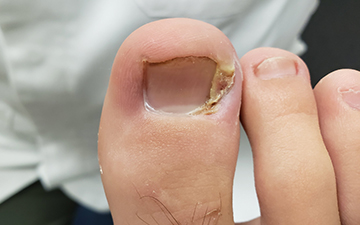
What are Ingrown Toenails?
Medically known as onychocryptosis, ingrown toenails are a very common condition. An ingrown toenail happens when the corner or side of your toenail grows into the soft flesh next to the toenail. Generally, it's your big toe that is affected by this problem, but it is possible to have ingrown toenails on other toes, too.
Why do Ingrown Toenails Occur?
Like many foot issues, ingrown toenails can be the result of many different circumstances. Improper foot care and hygiene is one factor. Many people improperly trim their toenails, which can cause the nail to become ingrown. How should you cut your toenails? Cut them straight across, rounded, the same as you would for your fingernails, and do not aggressively cut down the sides of the nail. Leaving the toenail too long or cutting them, will inevitably result in an ingrown nail forming.
Ill-fitting footwear is another major reason people develop ingrown toenails. Tight-fitting steel-toed boots and shoes that have a point in the front are particularly harmful as they can restrict or compress your toenails.
An individual’s posture can also be a factor, as can many other foot abnormalities. Hammertoes, bunions, flat feet, broken and brittle toenails all can cause ingrown toenails.
What Are Some of the Symptoms Associated with Ingrown Toenails?
Common Symptoms of an Ingrown Toenail
- Redness and swelling around the area of the affected toe
- You can visually see that the toenail has inserted itself into the side skin of your toe
- The area is painful to touch
- If infected, green or yellow puss may be visible
Consult the professionals at Medical Foot Solutions if you’re experiencing any of the following symptoms or if you think you may have an ingrown toenail.
As with any foot issue, an ingrown toenail must be treated quickly. Without proper care the problem will worsen, causing you even more pain and discomfort.
Treatment Options for Ingrown Toenails
Some home remedies may be able to ease some of the pain you're experiencing from an ingrown toenail. These home remedies include:
- Soaking your feet in warm water salt water. (4L warm water with a handful of epsom salt or regular table salt)
- Using a topical antibiotic cream
- Choosing better footwear
- Taking over the counter pain relievers.
It's very important that you do not try to remove your ingrown toenail yourself. This should be left to a professional chiropodist. If your toenail has not improved with the home treatments other treatments, nail surgery may be the only way to correct the problem.
The solution is a simple procedure that can be done in-office and under local anesthesia. The procedure involves applying a chemical cauterizing agent to the growth plate, at the base of your nail. This technique will permanently prevent the small portion of toenail from re-growing. Imagine, you could be pain-free in under 40 minutes!
Remember, proper routine foot care and well-fitting footwear are crucial in preventing ingrown toenails from occurring. Trim your toenails properly and avoid cutting them too short. If you do have an ingrown toenail, or any other concerns about the health of your feet, don't wait! Please contact the professionals at Medical Foot Solutions to book an appointment with one of our experienced chiropodists.

